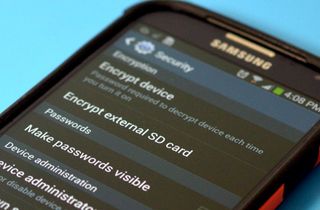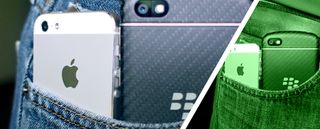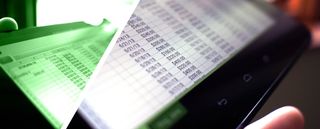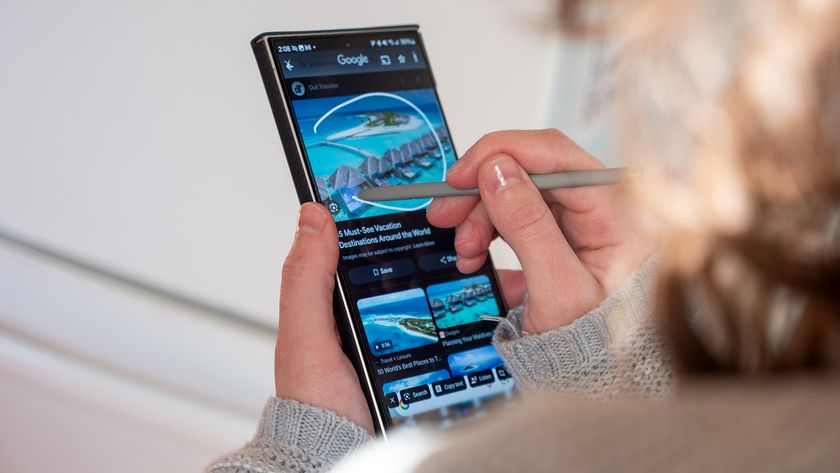All work and no play makes my smartphone something something - Talk Mobile

Presented by Blackberry
Talk Mobile Security
All work and no play makes my smartphone something something...
by Rene Ritchie, Daniel Rubino, Kevin Michaluk, Phil Nickinson
There was a time when the smartphone was a tool of the businessman. The BlackBerrys and Treos and Windows Mobile smartphones were connected corporate networks - and often issued by those corporations. Over the last several years that has changed dramatically, with smartphones becoming the province of the consumer.
So prevalent has smartphone usage become among the general public that corporations are beginning to perform a 180 on smartphone policy. They're increasingly comfortable with you hooking up your personal device to their secured corporate network.
Does that mean we need a new breed of device, something that can balance the needs of the personal user and the business user? Or do we already have the smartphones and tablets that can do that? And how do you manage the distraction of the personal at work and the work at home? Would we be better off just shoving the phone into a drawer throughout the day, or is there benefit to being able to pick it up and get in a quick Facebook check?
Be an expert in 5 minutes
Get the latest news from Android Central, your trusted companion in the world of Android
Navigating the world of smartphones and business, work and personal, isn't the easiest thing, but there's got to be a solution, right?
Let's get the conversation started!





Work vs. Personal
Articles navigation
- Dual-use devices
- Video: Scott Totzke
- Drawing the line
- Video: Michael Singer
- Work devices at home
- Distraction at work
- Comments
- To top

Kevin Michaluk CrackBerry
A dual-persona smartphone for work and play
It became that way for a reason. BlackBerry killed at enterprise but didn't adapt fast enough to ride the mainstream smartphone revolution wave. Neither did Microsoft. Apple and Android, meanwhile, didn't have their enterprise act together as they rose in consumer awareness.
So people were stuck with phones that were great for just half of their lives. Some suffered trying to get work done on an iPhone or Android, or trying to have fun with a BlackBerry or Windows Mobile. Or they tried carrying two phones and dealing with the requisite overhead.
Now it's 2013. Bring-Your-Own-Device has brought iPhone and Android into enterprise, and entirely new platforms have brought Windows Phone and BlackBerry 10 fully into the personal space.

Fort Samsung
Introduced in early 2013 alongside the Samsung Galaxy S4, Knox is Samsung's take on mobile enterprise security on consumer devices. Knox is designed to segregated work and personal data on Samsung devices, securing the apps and services needed for enterprise IT while protecting the employee's privacy in their consumer apps and services. Samsung claims that Knox "addresses all major security gaps in Android."
Knox includes a customizable secure boot to limit the installation and running of applications and a Knox Container environment for running launcher, apps, and widgets in a self-contained 'sandbox' that is segregated from the rest of the memory and encrypted by a 256-bit key.
Samsung's also partnered with Centrify, bringing their Active Directory secure cloud sign-on to Knox-enabled devices. This enables users on compatible corporate cloud services to log in once and access multiple mobile services.
So can one device now do it all?
With BlackBerry 10, the idea of "dual personas" is baked right into the device. With BlackBerry Balance you essentially have two phones in one, a secure enterprise partition for work, and another for personal stuff. You can change between the two elegantly and easily - swipe down on the home screen, tap an icon, and you're either on the job or off.
When in work mode, you get all your work features and the company gets all their security as well. You can access your enterprise services and apps, and the IT guys can enforce security policies to ensure data is kept safe. When you're in personal mode, it's your stuff and IT has no window into it.
It's the best of both worlds, and something all platforms should embrace.
That's the best of both worlds, and it's something I'd like to see all platforms embrace. Right now you can sort of do something similar with third party apps that sit on top of the OS, but that doesn't provide the same level of integration or the seamlessness of a built-in solution.
The ability to securely switch accounts is a basic service of traditional computing. It's time for it to become a basic service of mobile computing as well.

As a consumer I can download Angry Birds, as an IT administrator I can worry about protecting the information I care about.
- Scott Totzke / Senior Vice President, BlackBerry Security
Q:
Talk Mobile Survey: The state of mobile security


Phil Nickinson ANDROID CENTRAL
A line of demarcation between work and personal
So many of us in so many professions are expected to be more accessible these days. That means that the line between your work life and your home life becomes increasingly blurry — if such a line exists at all anymore. So how do you find that balance?
For some, the answer is to fight to reclaim and define the line. Fight for the ability to leave work at work, and home at home. The ability to not answer e-mail until you're actually in the office. That skirts the object of our little exercise here — and probably puts limits on any number of careers now — but balance can be found through mutually exclusive means.

Options, options, options
When it comes to getting your work email on your personal smartphone, there are three major systems at play that the major smartphone platform support. The most basic is IMAP - Internet Message Access Protocol - allowing for two-way communication between a device and server. IMAP supports notifications of new emails though not pushing of the entire message. As an open source protocol, IMAP is found in virtually every smartphone platform.
Microsoft Exchange ActiveSync is a favorite of businesses and is likewise supported by the major platforms. EAS supports email, task, calendar, and contact syncing and has offered push email since 2005. EAS is used by thousands of businesses and millions of employees worldwide - even Google offered EAS access to Gmail for years.
Google Apps is the third option. Accessible through a web interface, IMAP, and Google's own APIs, Google Apps offer Gmail-style services but with a corporate address. With the exception of Google's own Android operating system, few devices offer built-in support for the Gmail API, though Google does offer open source IMAP, CalDAV, and CardDAV alternatives.
For others, the best approach is to ignore the line. Obliterate it. There is no line between work and home — there is only the time spent on one or the other. While that sounds more than a little invasive, it can work. Don't worry about the line, and just learn to go with it.
The trick then is that while you can work any time, in fits and starts, you shouldn't necessarily work all the time. You have to know when it's okay to deal with work at home, and when it's not distractive to deal with home business at work.
While you can work any time, you shouldn't necessarily work all the time.
A third option requires more willpower. Embrace the line of demarcation, but respect it as well. Work when you're expected to work, and ignore work when you're expected to be at home. Some of the new workspaces such as Samsung's SAFE and BlackBerry Balance help with that. Treat them like the front door of an actual office and stay the hell away when you're expected to.
We've talked previously about how being online 24-7 doesn't — and more to the point shouldn't — mean that you're available 24-7. Every job is different, of course. But unless you're a doctor or leader of a sovereign nation, chances are you're really not as important as you like to think you are, and life will, in fact, go on for an hour or two while you unplug.

A single device can have multiple personas. It can have a personal side and an enterprise side.
- Michael Singer / Senior Vice President, BlackBerry Security
Q:
How do you find a balance between work and personal?
876 comments


Rene Ritchie iMORE
Work gave me a smartphone, now work follows me home
Being given a mobile device by your work is a two-edged sword. By that I don't mean that it has its pros and cons. I mean it draws blood.
There's no such thing as a free phone or tablet. Any technology perk comes with it an expectational debt. The boss didn't give you a shiny new smartphone so you could show off to your racquetball buddies. The boss gave it to you so they could BBM you at 2 in the morning on a Sunday to make sure you're fixing their presentation for Monday, or whatever other thing could just wait for a more reasonable hour.
Forget strings attached. In the modern mobile workplace almost everything comes with industrial strength cables welded to the frame.

Death by smartphone
From 2006 to 2013, Carsten Schloter stood as CEO of Switzerland's largest telecommunications company, Swisscom. On July 23, 2013, Schloter was found dead at his home, a victim of a presumed suicide.
Schloter's tenure as the CEO of Swisscom was not without controversy, and that trouble spilled over into his personal life, resulting in a separation from his wife and three children in 2009. In two candid interviews in 2012 and 2013, Schloter revealed that he was suffering stress from the very technology that had elevated Swisscom and his stature in the business world: the smartphone.
Speaking with Swiss newspaper Schweiz am Sonntag, Schloter said that "The most dangerous thing is to fall into a mode of permanent activity and continuously consult one's smartphone to see whether any new mails have come in. Everyone should switch off their mobile phones from time to time." But asked whether that was something he could do, he admitted, "I find it increasingly difficult to calm down and to reduce tempo."
Read receipts, pioneered by BlackBerry Messenger but since then widely adapted by many other, similar services, seem like a great idea when you send them and you can safely know your messages have been read. When your boss rages that it took you 20 minutes post-read receipt to respond, suddenly you wish they'd never been invented.
Powerful mobile computers that fit in our pockets seem like miracles when we can watch a funny video or talk with our family from across the country. Not so much when we're woken up in the middle of the night to fix the thing and talk to the person.
First world problems, I can hear you thinking already. (Why do you think so loudly?) Thanks to mobile devices we can still be "working" while we sneak out to the game after lunch, or get in overtime from the backyard deck, or file that report just before Disneyland opens for the day.
Like any tool, it is what we make of it.
Like any tool, at the end of the workday it is what we make of it. If we set firm boundaries, if we employ bedside mode and do not disturb, if we keep our devices in our pockets when out with our families, and if we otherwise tell people, including our bosses, what is and is not acceptable in actions and not just words, then work phones and tablets and even laptops can be great.
Because, bottom line, just because technology enables us do something, doesn't mean we have to let it.
Q:
Does having a work smartphone mean you're always "on the job"?
876 comments


Daniel Rubino WINDOWS PHONE CENTRAL
Distraction will always find a way
There is little doubt that modern technology, especially the internet and mobile devices, have had a positive impact on productivity. The flip side is that those same devices now act as distraction to many employees, leading many IT departments block certain "time waster" websites like Reddit and Facebook. With those sites blocked on the corporate network, employees often just resort to their personal mobile devices with outside connectivity to get their fix.
Granted, these are sweeping generalizations, but you don't need to look far to see the impact of such "second screening" (using another display from a computer, tablet, or phone while simultaneously using another device). Hitting the bathroom now serves two purposes: to let nature have her way, and for you to catch up on Twitter, Facebook, and play Angry Birds until you've lost feeling in your feet.

Jamming up the signal
Theaters, teachers, and restaurants alike have one thing in common - the desire for a quiet, distraction-free experience. That led to a relatively small uptick in the early 2010s in sales of cellular signal blockers. The small devices, typically battery-powered and with a range of 30-45 feet, were available for cheap from overseas, sometimes as low as $25 per unit.
The jammers work by transmitting noisy interference signals along the same electromagnetic bands as cellular communications. The end result is the phone isn't able to find the relatively weak tower signal among the noise from the jammer. More powerful jammers offered to governments and law enforcement can work over a range of miles.
It's no surprise that cell phone jamming is illegal for civilians in the United States. Using jammers blocks 9-1-1 services and can interfere with other wireless communications. It was the Communications Act of 1934 that made jammers illegal, specifically by banning interference with radio communications in public.
Personal discipline and age are two factors that will probably determine to what extent your phone is a distraction at work. For some, simply putting the phone away is key to managing the distraction, while others either by age or choice aren't as ensconced in modern technological frippery and don't have to deal with it to begin with.
But what about the adolescent generation that is being raised with multiple screens? Will employers need to have "no smartphone policies" where employees have to keep their devices stowed away, or will the employers implement cellular blockers to enforce it? Or is smartphone self-control simply a function of age, maturity, and dedication?
While blocking sites or signals may seem draconian, employers ultimately care about one thing: productivity. If there was ever a threat to that metric, it would be the proliferation of powerful constantly-connected big-screened smartphones.
Is smartphone self-control simply a function of age, maturity, and dedication?
One could argue that back in the day, the choice of your device could determine the outcome in the constant back and forth between work and play. For instance, BlackBerry still has a reputation of being "more serious" when it comes to labor than when compared to an iPhone or Android. That is all changing now, thanks in part to the Bring-Your-Own-Device policies that are slowly becoming the norm, and BlackBerry today has had to shore up its devices to be more "fun".
In reality though, these issues aren't going away and as mobile broadband becomes more ordinary along with the propagation of affordable smart-devices, employers and employees will have to reach a common ground to maintain the work-play dynamic.
Q:
Has having a personal smartphone changed how you work?
876 comments

Conclusion
There is no good answer that covers all of the bases. If you have two smartphones, one for work and one for personal, that's two devices you have to manage. And that pretty much defeats the purpose of the smartphone in the first place. Or you could use your personal smartphone for work stuff, but then you have to deal with your personal smartphone being your work smartphone.
When does work stop and personal begin? When it's all on the same device and always with you, that line becomes hazy, ever-moving, and sometimes just plain evaporates. It's up to us, every day, to draw that line.
It's up to our employers too. They shouldn't have tell us when we can and can't use our personal devices at work. We should be able to handle that distraction ourselves. After all, we're at work for a reason. That reason being to work.
There are technical balances between work and personal with systems like BlackBerry Balance and Samsung SAFE, but the majority of the balance is up to us. We have to set lines and standards, we have to self-enforce and self-police. Where do we draw that line and how do we decide when to step over it?



